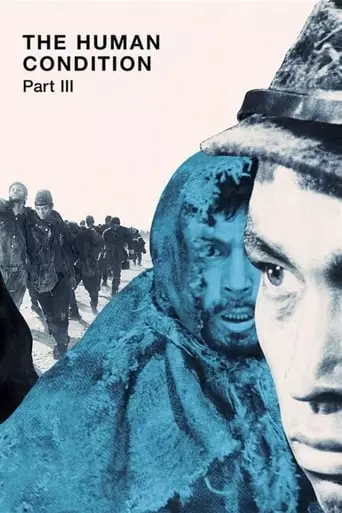
The Human Condition III: A Soldier's Prayer (1961) Watch Online Free
After the Japanese defeat to the Russians, Kaji leads the last remaining men through Manchuria. Intent on returning to his dear wife and his old life, Kaji faces great odds in a variety of different harrowing circumstances as he and his fellow men sneak behind enemy lines.
The Human Condition III: A Soldier’s Prayer is the final installment in Masaki Kobayashi’s epic trilogy, following the journey of Kaji, a Japanese pacifist conscripted during World War II. This film delves into the harrowing experiences of Kaji as he navigates the brutal realities of war, captivity, and the collapse of his ideals.
Plot Summary
After the defeat of the Japanese forces, Kaji and a group of fellow soldiers attempt to evade Soviet capture by traversing the treacherous Manchurian wilderness. Their journey is fraught with peril, including starvation, disease, and the constant threat of enemy forces. As they struggle to survive, Kaji’s commitment to his pacifist principles is severely tested. The group encounters various hardships, including betrayal and the moral dilemmas of survival, leading to the disintegration of their unity. Ultimately, Kaji is captured by Soviet forces and subjected to the harsh conditions of a labor camp, where he faces the ultimate test of his humanity.
Themes
The film explores profound themes such as the dehumanizing effects of war, the conflict between personal ideals and survival instincts, and the disillusionment with political ideologies. Kaji’s journey reflects the erosion of his socialist and pacifist beliefs as he confronts the brutal realities of war and captivity. The narrative also examines the collapse of social structures and the moral decay that ensues in extreme circumstances. Through Kaji’s experiences, the film critiques the futility of war and the fragility of human ideals when faced with overwhelming adversity.
Impact of the Movie
Upon its release, The Human Condition III: A Soldier’s Prayer received critical acclaim for its unflinching portrayal of the human condition during wartime. The film’s stark realism and emotional depth resonated with audiences and critics alike, solidifying its place as a significant work in Japanese cinema. Its impact extends beyond its immediate reception, influencing subsequent war films and contributing to discussions on the morality of war and the resilience of the human spirit.
The film offers an unvarnished portrayal of the horrors of war, capturing the physical and psychological toll on individuals. Its realistic depiction challenges romanticized notions of combat, providing a sobering perspective on the human cost of conflict.
Kaji’s evolution from an idealistic pacifist to a man confronting the brutal realities of war is portrayed with depth and nuance. This transformation offers a compelling study of character under extreme duress.
Kobayashi’s direction is both meticulous and evocative, creating a film that is both visually stunning and emotionally resonant. His ability to convey complex themes through subtle storytelling techniques sets The Human Condition III apart from conventional war films.
The film’s raw and unfiltered depiction of wartime experiences elicits a profound emotional response. Its unflinching realism immerses viewers in the harrowing journey of its characters.
The film’s cinematography and production design are exceptional, with each frame meticulously crafted to enhance the storytelling. The visual style complements the narrative, creating an immersive experience.
The Human Condition III delves into themes of morality, survival, and the human spirit, prompting viewers to reflect on the nature of humanity in the face of adversity. Its exploration of these themes adds depth and complexity to its narrative.
The film received critical acclaim, including the Special Jury Prize at the 1961 Cannes Film Festival, highlighting its artistic excellence and impact on cinema. Its recognition underscores its significance in the film industry.
The Human Condition III has influenced numerous filmmakers, contributing to its status as a classic in world cinema. Its innovative approach to war storytelling continues to inspire contemporary films.
The film offers an authentic portrayal of Japanese culture and the societal impact of war, providing viewers with a deeper understanding of Japan’s wartime experience. This cultural insight enriches the viewing experience.
Spanning nearly ten hours across three films, The Human Condition offers an epic narrative that allows for deep character development and a comprehensive exploration of its themes. This expansive storytelling provides a rich and immersive experience.
After viewing The Human Condition III: A Soldier’s Prayer, you may experience a profound sense of reflection and introspection. The film’s unflinching portrayal of the human cost of war and the moral complexities faced by its characters can evoke deep emotional responses. You might feel a sense of empathy for the characters’ struggles and a heightened awareness of the harsh realities of conflict.
The film’s stark realism and emotional depth may leave you with a lingering sense of unease and contemplation. Its exploration of themes such as the erosion of ideals, the dehumanizing effects of war, and the resilience of the human spirit can prompt you to reflect on the nature of humanity and the impact of conflict.
